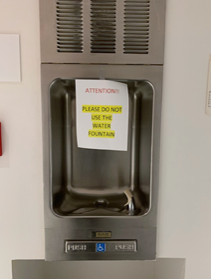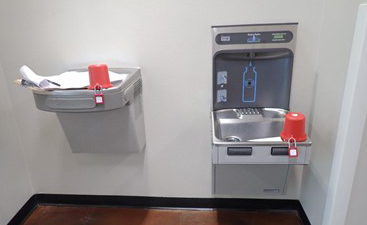
We see them in office building corridors and wonder who uses them except for leftover coffee disposal. The local building code requires it, but is this one of those antiquated parts of the code that may need to be reevaluated? In early movies and television shows, the proverbial conversations at the water bottle station were business office norms. As civil rights in the early ’90s required the station to be converted into a hi-low drinking fountain for accessibility, the impromptu meetings have now moved to office break rooms, inter-office corridors, or “collision areas” as we architects/interior designers call them.
Since the pandemic, I see the drinking fountain with warning signs, danger zone strips, and red cups over the waterspouts stating “do not drink.” The pandemic has increased the lack of use of this fixture. I even questioned the legality of temporarily closing these drinking fountains in the first place, for they are required by building code after all.
The drinking fountain requirement has been a part of the building code for many years. We have continued to add them as part of the accessibility requirement even in our 2018 international building code (chapter 29) and its plumbing fixtures requirements (2018 IPC, chapter 4). However, now that the pandemic has brought the drinking fountain back into question, maybe we need to either remove the use or make adjustments to the plumbing code to become more functional.
As the head of my firm’s QA/QC division, I review the building codes, regulations, and office standards almost every day regarding the use and functionality of the building code. The drinking fountain is one of those items I get questioned on practically every time. I see either buildings removing them, stating that no one is using them, not knowing that it is still required by code, or left abandoned with bleach stains on the common corridor carpet below and has a peculiar smell due to the p-trap drying up in the fountain because of lack of use.
The significant differences between the drinking fountain and water dispenser are often used interchangeably; technically, a drinking fountain dispenses water without cooling it. A water cooler cools the water using an internal refrigeration system. In comparison, a water dispenser can also be a water cooler that dispenses heated water. The water dispenser can also be bottled water or a point of use.
The building code does not regulate drinking fountains. For the regulations, you must go to the plumbing code. The plumbing code is very specific in requiring the drinking fountain to conform to ASME A112.19.1M, ASME A112.19.2M, ASME A112.19.9M, or ARI 1010. None of these standards includes a drinking dispenser. Hence, a plumbing inspector is within their rights to prohibit a water dispenser and mandate a drinking fountain.

If you wonder whether a combination drinking fountain/water bottle filler can count as two fixtures for meeting the plumbing code requirements, the answer is no. Only one person can use the combined fixture at a time. Therefore, it is one fixture.
In the 2018 International Building Code (IBC), the enforcement of the drinking fountain is stated in chapter 11 accessibility requirements for drinking fountains to be accessible for disabled and able-bodied persons. This is the section where we are required to provide the standard “hi-low” drinking fountains. We further see the requirements for drinking fountains in chapter 29, which is referenced from the International Plumbing Code (IPC). The code states for business use, one fixture is needed for every 100 occupants on a floor. Therefore, providing drinking fountains is part of the building core requirements as part of the base building design.
In most projects I’ve reviewed and observed in other firms, providing a coffee maker with a water spigot and/or water bottle filler is now the standard. The building code view of this installation allows the tenant to use this as part of the fixture count as long as you first start with the hi-low drinking fountain (see section 2018 IBC section 1109.5 and 2902.1). I propose to resolve the issue of the hi-low requirement. We can provide a water bottle filler station that is reachable for non-disabled and disabled persons. If you must, add a drinking fountain as part of the installation. As part of the water bottle fillers and recycling generation, I must admit that this is a viable solution.
I have noticed in a few jurisdictions that allow the drinking fountain to be part of the tenant design instead of the building providing these fixtures. On one project, I was baffled as to why the common corridors did not have standard drinking fountains until I researched to find out the review of this code section was superseded by the local water municipality, which removed the section for the hi-low drinking fountain with the approval of water bottled filler stations or dispensers that they meet the height and clearances of their accessibility guidelines.
At this point in the building code, the requirement for the hi-low drinking fountain should be reevaluated and provide fixtures that will be more functional and accessible. Starting in your state building code review board for a building code revaluation or writing to your local Building Code Official or Permit Leader will be the spark to make issues like this happen. Anyone who deals with the building code regularly knows that making a change will take baby steps, and providing a water bottle filler with a low drinking fountain as the building standard can be a start.
About the author
Kevin Sneed, FAIA, IIDA, LEED AP BD+C, is Senior Principal, Senior Director of Architecture at OTJ.
The opinions expressed in this piece do not necessarily reflect the views and opinions of Inform Magazine, its agents and/or affiliates.
